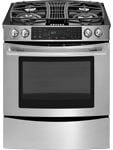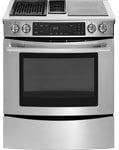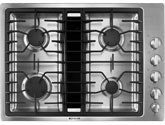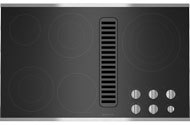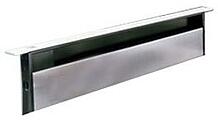A downdraft appliance redirects steam and grease from the cooking surface down through the product itself or via a separate blower to the outside.
First, let's discuss ventilation or how to remove bad odors and heat out of your house (so your house doesn't smell like bad odors). Ventilation is a simple concept. In order for the bad stuff to be removed, you need the following:
- Good CFM: CFM is an acronym for cubic foot per minute or how many cubes of air can be removed in a minute. So a 900 CFM blower removes 900 cubes of air. Blower speed is essential in pushing or pulling odors out of your home especially with professional ranges or even high output gas ranges in general.
- Capture area: Capture refers to the amount of area in a hood where smoke can be pooled. Even with a high CFM blower, smoke from wok, grilling and other "heavier" cooking smoke is channeled until the blower can force it out of your home. Larger hoods, for that reason, are the best choice for pro-type cooking.
- Duct run: The optimimum duct run should be straight up mimicking how smoke travels. Horizontal or straight back is a viable option. Bending or elbowing venting greatly reduces efficiency so avoid as much as possible. Also, shorter runs are more efficient.
- Duct Size: Do not use 4 inch dryer duct as smoke will never be exhausted efficiently. 6 inch round duct should be minimum with 8 or 10 inch ducting the standard with professional cooking.
Downdrafting should be considered a last option only. Look at island hoods manufactured by Zephyr or Faber because downdrafts have zero capture area and the duct runs are usually bent a couple of times and are too long to be effective.
Still a downdraft is sleeker and many times is the only option for ventilation, so let me show you best practices.
How to downdraft a range:
This is easy. Jenn-Air is the only manufacturer of downdraft ranges as GE, Roper, Amana and Modern Maid have long exited this niche. It is integral in the middle of the unit and available in electric and dual fuel. The blower is roughly the same as an over-the-range microwave at 310 CFM, so keep the cooking on the light side (or open a window).
How to downdraft a cooktop:
Jenn-Air has a downdraft as well, which is identical to the range in blower speed, but the better option is a separate downdraft unit with a cooktop. You can choose any cooktop, as well as have a more powerful blower up to 1500 CFM. Zephyr, Faber, Viking, Wolf, Broan and Thermador all market this type of downdraft.
Have a look at both:
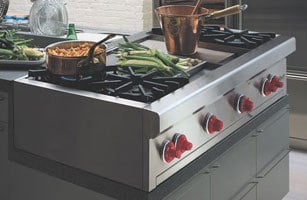
One word of caution, don't try this at home...
A few manufacturers still recommend this type of installation of a pro cooktop with a downdraft, but it is not an appropriate solution. If you are facing this quandary, consider induction, which is more powerful than a professional cooktop but emits much less heat.Downdrafts were first manufactured 30 years ago, and the blower speeds have been improved in the last few years. However, they are not equipped to handle the heat output of a professional range. Remember, there is almost no capture area in a downdraft, so the smoke will almost bypass the downdraft completely.
For more about downdrafts and ventilation in general, consult our Ventilation Buying Guide with best practices, products and features.


